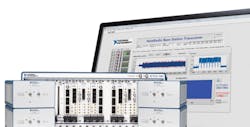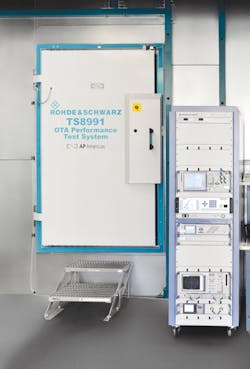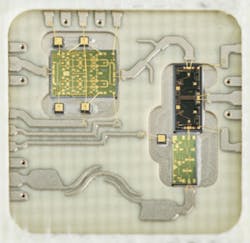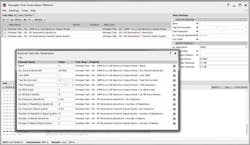Pursuing innovation from massive MIMO to hybrid beamforming
The rollout of 5G should accelerate in earnest in 2018. If there’s a specific deadline spurring on action, it might be the 2018 Winter Olympics, commencing Feb. 9 in PyeongChang, South Korea. In September, South Korean mobile carrier KT said it had signed an agreement with Korea Expressway Corp. (KEC) to begin deploying 5G infrastructure along PyeongChang roadways. RCR Wireless News quotes Kim Young-in, senior vice president of KT’s network division, as saying, “Based on the agreement with the KEC, KT will be able to provide more visitors with chances to experience 5G services ahead of their commercialization.”1
Other companies can take a more leisurely approach to implementing 5G. FierceWireless2 reports that AT&T remains on track to launch 5G services by the end of 2018, but hasn’t defined the initial use case.
Nevertheless, companies from silicon vendors to makers of test equipment are pursuing 5G technologies. The recently released NI Trend Watch 2018 quotes Patrick Moorhead, president and principal analyst, Moor Insights and Strategy, as saying, “Ten years from now, we’re going to look back and say that 5G was one of the most important pieces of technology ever”—enabling everything from self-driving cars to amazing video experiences.3
The NI Trend Watch points out that 5G requires inputs from companies specializing in semiconductors, network infrastructure, the cloud, software, manufacturing, and test, as developers contend with massive MIMO and mmWave technologies, which in turn require multiple antennas and beamforming. Further, algorithms developed in a model-based environment will require real-world validation. The company recommends a platform-based approach employing software-defined radios (SDR) such as has been employed by Lund University in developing a massive MIMO prototype.4
The NI Trend Watch notes that test and measurement will be key to the 5G commercialization cycle, with test strategies having to address bandwidths 50 times larger than those of LTE channels. In addition, test engineers may have to contend with loss of access as phased-array-antenna modules emerge with antennas directly attached to RF front ends. Speaking at a panel session at EDI CON USA in September in Boston, Michael Schneider, NI principal product manager, cited the need to bring mmWave test down in cost and also emphasized the importance of over-the-air (OTA) test. Challenges extend from unpredictable environmental conditions to wireless engineers’ need to control a device under test on a per-beam basis.
Rohde & Schwarz has also commented on OTA test. At mmWave frequencies, signal absorption rates are high, requiring directional transmission/reception (beam focusing or beamforming) to boost gain, the company noted in a September press release introducing an enhanced OTA test system. Requirements include the measurement of EIRP/EIS, beam-transmit-signal quality, beam-receive performance, beam-acquisition timing, and beam-tracking performance as well as side-lobe measurements. The company added that high levels of component integration will make it difficult to connect test equipment to DUTs, and even if test access were not a problem, cable costs and losses at mmWave frequencies would be prohibitive.
A half-decade view
Of course, whatever progress occurs in 2018 will only be setting the stage for future innovation. Speaking at EDI CON USA in Boston in September, Thomas Cameron, CTO of the communications business unit at Analog Devices Inc., looked out five years, citing the Ericsson Mobility Report prediction of 500 million 5G subscribers by 2022.5
Cameron offered an overview of 5G, saying key aspects include high performance, low latency, high device density, long battery life, high energy efficiency, and high reliability. It will offer broadband everywhere (eMBB, or enhanced mobile broadband), massive connectivity (mMTC, or massive machine-type connectivity), and mission-critical support (uRLLC, or ultrareliable low-latency communications). He said 3GPP’s proposed New Radio (NR) is expected to be deployed in new spectrum, with the NR waveform similar to LTE CP-OFDM (cyclic-prefix orthogonal frequency division multiplexing). Beamforming will be prevalent above 2 GHz.
Sub-6-GHz 5G implementations will be characterized by massive MIMO, digital beamforming, high radio count (64t64r), and an evolution from current BTS technology, he said. Benefits such as spectral-efficiency improvement have been demonstrated, and sub-6-GHz 5G offers the possibility of compatibility with existing UEs. Challenges to be addressed relate to size, weight, power consumption, cost, complex antenna interfaces, and fronthaul issues. Areas for innovation include filter size and weight (through materials, design, and algorithms), power-amplifier efficiency (through GaN processes, Doherty circuitry, and digital predistortion, or DPD), and radio size and power (through architecture, integration, algorithms, and platforms). He foresees heterogeneous integration with CMOS and other process technologies. “We have brought CMOS to bear on radio,” he said.
Hybrid beamforming
Moving beyond 6 GHz up into the mmWave bands, Cameron said he anticipates very high antenna count with hybrid beamforming. Benefits at mmWave frequencies include utilizing the large available spectrum to deliver high data rates. Challenges relate to channel models, fading, beam acquisition and tracking, power consumption, and cost, he said.
Hybrid beamforming is a technology applicable to 5G that’s being addressed by MathWorks. Rick Gentile, product manager, Phased Array System Toolbox and Signal Processing Toolbox, explained that hybrid beamforming employs both analog beamforming and digital precoding techniques to intelligently form the patterns transmitted from a large antenna array, with an analogous technique on the receive side, deriving the desired received pattern. The technique is crucial in 5G, he added, because of cost and power constraints.
To assist with hybrid beamforming development, MathWorks offers MATLAB add-on products such as Antenna Toolbox, Phased Array System Toolbox, and RF Blockset, he said, adding, “MATLAB provides a flexible platform to explore algorithms and build system models before any hardware is developed.” In addition, the company’s Simulink helps engineers explore system-level architecture tradeoffs and perform multidomain RF/digital system simulations.
5G products and technologies
Companies have announced a variety of 5G-related products and innovations since our last look at the topic in a print issue.6 For example, Cobham Wireless in May introduced its TM500 5G test solution, which provides operators and network-equipment manufacturers with a scalable system to test network performance as experienced by users. The system can simulate multiple devices connecting to a 5G network, modeling real-world conditions. The company said the TM500 facilitates the transition from legacy to future standards, offering flexible deployment options. It can validate 5G features such as carrier aggregation and beamforming and can verify networks operating across multiple frequencies in the mmWave and sub-6-GHz bands.
In addition, AceAxis in May launched a millimeter-wave test system, initially targeted at 28 GHz, for characterizing the RF performance of prototype high-frequency components and systems for 5G. Building on AceAxis’s background in the design and supply of remote radio units (RRU) for 4G mobile networks, the Millimetre-Wave 5G Test System extends the capability of the existing AceAxis 4G modular test system. The new modules offer a compact, flexible solution for the emulation and aggregation of very wideband 5G radio channels at millimeter-wave frequencies. The modular design means that it is fully configurable to meet current and future standards and frequency bands.
As for NI, the company this year moved its NIWeek event in Austin from the traditional August date to May, giving the company a venue to introduce a series of 28-GHz radio heads—the mmRH-3642, mmRH-3652, and mmRH-3602—for its mmWave Transceiver System. This combination creates what the company calls the first commercially available full transceiver of its kind that can transmit and/or receive wide-bandwidth signals of up to 2 GHz of bandwidth in real time, covering spectrum from 27.5 GHz to 29.5 GHz. The mmWave Transceiver System software- defined radio (SDR) and application-specific software offer a comprehensive starting point for 5G measurement and research addressing both the 3GPP and Verizon 5G specifications.
The mmWave Transceiver System (Figure 1) can operate as either an access point or user device in any over-the-air testing scenario. Users can also develop mmWave communication prototyping systems or perform channel measurements—necessary exercises for wireless researchers to understand the characteristics of a new spectrum—using the same system. The software works with the previously released radio heads for 71 to 76 GHz, so users can easily adapt their mmWave Transceiver System to 28 GHz by changing the RF radio heads.
In addition, the company said, the mmWave Transceiver System baseband software delivers a communications physical layer compatible with the proposed 3GPP and Verizon 5G specifications as source code for LabVIEW system design software, helping expedite system development by delivering a ready-to-run system that users can modify to adapt to their specific areas of research or testing.
Courtesy of National Instruments
The company followed up in June at the International Microwave Symposium in Honolulu with the introduction of the PXIe-5820 baseband model of NI’s second-generation Vector Signal Transceiver (VST). The introduction followed an earlier announcement of a pre-5G waveform generation and measurement technology demonstration at IMS.
NI described the PXIe-5820 module as the industry’s first baseband VST with 1 GHz of complex I/Q bandwidth; it is designed to address challenging RF front-end module and transceiver test applications, such as envelope tracking, digital predistortion, and 5G test.
Also at IMS, the company demonstrated pre-5G waveform generation and measurement technology, featuring signal generation and analysis of waveforms representative of both the Verizon 5G Technical Forum (5GTF) and the 3GPP’s proposed NR physical layers.
The technology demonstration combined the 1-GHz bandwidth of the PXIe-5840 VST with pre-5G software for waveform modulation and demodulation. Key features of waveform modulation include support of both discrete Fourier transform spread orthogonal frequency division multiplexing (DFT-S-OFDM) and orthogonal frequency division multiple access (OFDMA) along with flexible subcarrier spacing and component-carrier configurations supporting 3GPP 5G NR and Verizon 5GTF specifications up to a combined total bandwidth of 1 GHz. The demonstration supported modulation types up to 256 QAM and delivered measurement results including power, adjacent channel power, and error vector magnitude. Typical applications include testing RFICs such as RF power amplifiers, front-end modules, and transceivers.
IMS provided a venue for other test-and-measurement companies plus device makers to highlight their products. On the test and-measurement-front, Keysight Technologies highlighted its SystemVue 2017 electronic system level (ESL) simulation software, which the company said provides the industry’s first Verizon 5G link level validation of 5G base station and handset designs. The software integrates adaptive RF phased-array MIMO beamforming in 5G mmWave channel environments with reference baseband modem and 28-GHz RFIC architecture.
Device introductions at IMS
As for devices, Anokiwave at IMS announced the expansion of its family of Ka-band 5G ICs with the worldwide release of what the company called the first commercially available 39-GHz silicon active-antenna quad-core ICs for 5G communications markets.
The AWMF-0123/5 ICs operate at 37.1 to 40 GHz, support four radiating elements, and include 5-bit phase control and 5-bit gain control for analog RF beam steering. Anokiwave’s patent-pending IP blocks implemented in silicon technology enable low-cost hybrid beam forming with high energy efficiency and low-latency beamforming, the company reported.
Also at IMS, Analog Devices announced an update to its RadioVerse technology and design ecosystem, which simplifies and accelerates radio development for wireless carriers and telecommunications equipment manufacturers as they transition their cellular base stations from 4G to 5G networks. ADI’s expanded RadioVerse portfolio features new radio transceiver hardware, software tools, and a robust design environment that enables the smaller, lower power radios necessary in next-generation networks. The new offering allows customers to evaluate and develop radio designs for 4G small-cell and pre-5G massive MIMO systems, enabling fast data rates while improving connectivity and data throughput in densely populated, high-traffic areas such as office buildings, sport stadiums, and public transit systems.
5G base stations and infrastructure
Companies have continued with innovation after IMS. The week after the event, Keysight Technologies announced a solution for measuring, analyzing, and visualizing the coverage generated by 5G base stations. Keysight’s Nemo Outdoor, combined with FieldFox handheld RF and microwave analyzers, enables mobile operators and network vendors to measure 5G radio propagation and coverage. The solution uses the Nemo Outdoor analytics tools to provide capabilities for visualizing and post-processing data, enabling network equipment manufacturers and mobile operators to evaluate and verify 5G base-station propagation models for indicating 5G cellular coverage levels.
Keysight said mobile operators require extensive measurements and research to gather information about cellular mmWave propagation in different radio environments—indoor and in the field, Keysight reported. Real-world 5G measurements allow operators to supplement and verify initial radio network plans and models.
Anritsu in June introduced the MS2850A signal analyzer, which the company said can cost-efficiently and accurately evaluate 5G signals with the 800-MHz modulation bandwidth (8 x 100 MHz) associated with 5G designs. With analysis bandwidth up to 1 GHz, the MS2850A provides wireless equipment manufacturers and mobile operators with a comprehensive and affordable tool to evaluate base stations and terminals as well as satcom and broadband communications equipment.
Engineers can use the MS2850A, which has a standard analysis bandwidth of 255 MHz that can be extended to 1 GHz, to evaluate Tx performance. The MS2850A supports 5G standards currently under development by 3GPP, as well as legacy technologies such as LTE, W-CDMA, TD-SCDMA, and GSM. Anritsu said the MS2850A fills a market void for an economical solution to accurately measure infrastructure under development for the emerging 5G market, as well as for other communications applications that have similar requirements, such as larger data capacity at faster speeds.
Software tools for 5G
Addressing software for 5G applications, Remcom in June announced diffuse scattering prediction in the latest release of Wireless InSite, its site-specific radio-propagation software for the analysis of wireless communication systems. The company said the update improves simulation accuracy for millimeter-wave systems being developed for 5G, WiGig, and other emerging technologies.
Wireless InSite simulates the detailed multipath performance of large numbers of MIMO channels while overcoming the increased level of computations required for traditional ray-tracing methods. As 5G technology forces expansion into higher frequencies in the millimeter-wave spectrum, the diffuse scattering model further increases precision by revealing how paths interact with a variety of surfaces and structures and how signal power is affected by these interactions, the company said. Key effects such as impact on complex impulse response and increased cross-polarization of received signals may be visualized.
NI has continued work on 5G since NIWeek and IMS. In July, the company announced multiple-antenna user-equipment (UE) support for its LabVIEW Communications MIMO Application Framework. This new feature enables a physical-layer reference design that powers true massive MIMO prototyping that goes beyond desktop simulations to fully functional 5G deployments, the company said.
Wireless researchers can pair the MIMO Application Framework with NI software-defined-radio hardware to conduct real-time, over-the-air experiments for a range of MIMO research topics including multi-user MIMO, single-user MIMO, and massive MIMO. The multi-FPGA physical layer reference design ships with LabVIEW Communications source code that is fully reconfigurable and modifiable, allowing engineers to create a complete network of multiple antenna devices with minimal system integration or design effort.
OTA test
Moving on to September, Mobile World Congress Americas 2017 in San Francisco provided Rohde & Schwarz the opportunity to showcase its enhanced OTA test systems to meet the new challenges of testing in 5G mmWave environments. The company described the R&S TS8991 OTA Performance Test System (Figure 2) as a single-source turnkey system for wireless testing that meets the needs of industry and regulatory certification tests. The R&S TS8991 includes an anechoic chamber, positioning equipment, antenna (link and measurement) systems, test instruments, and automated measurement software. It is compliant with CTIA, joint CTIA and Wi-FI Alliance, and 3GPP test plans. The test system is available in different sizes, and its modular system design allows for customer-specific configurations. Systems can be custom-designed to meet specific requirements in terms of size, functionality, frequency range, and applications.
Courtesy of Rohde & Schwarz
Rohde & Schwarz also announced that PCTEST Engineering Laboratory Inc., an ISO-17025 accredited laboratory for wireless testing and certification, has upgraded its RF, protocol, and RRM (radio resource management) test platforms for conformance testing of License Assisted Access (LAA), 5CC carrier aggregation, and 8 x 4 MIMO to support new high-speed devices entering the market.
Rohde & Schwarz reported that as the mobile industry moves towards 5G, mobile operators are looking for new ways to maximize data rates by accessing more spectrum. License Assisted Access, introduced in 3GPP Release 13 as part of LTE Advanced Pro, uses carrier aggregation in the downlink to combine LTE in the licensed band with LTE in unlicensed spectrum. With LAA, the licensed spectrum carries the control and signaling information, while the unlicensed band is aggregated together to carry more data, allowing the mobile operator to achieve faster data rates while maintaining a high quality of experience for the end user.
“As the capabilities of mobile devices evolve toward the projected functionality of 5G, testing becomes increasingly complex and at the same time, more important,” said Randy Ortanez, PCTEST president, in a press release. “At PCTEST, we’ve continued to advance our testing capabilities and technical expertise to support our customers for this next wave of complex, high-performance RF devices. 5G is right around the corner, and we are pleased to be working closely with Rohde & Schwarz to help us meet the needs of this fast-changing market.”
Also in September, Guzik Technical Enterprises announced the ADP7000 Series AXIe modular digitizers with combined signal processors for the emerging 5G communications test market and related applications. Based on a proprietary ADC from Keysight and paired with Intel Arria 10 FPGAs, the ADP7000 offers the fidelity, speed, and processing capability required by 5G wireless communications in one standard package, the company said.
“With the ADP7000 Series we have broken the twin barriers of direct wideband RF signal conversion and processing power needed by advanced communications technologies such as 5G,” said Lauri Viitas, vice president of product and business development at Guzik, in a press release. “By using a Keysight 10-bit ADC, unavailable on the open market, we are able to directly sample RF signals up to 32 GS/s on two channels simultaneously. Multiple ADP7000 modules can be combined to increase the number of phase-coherent channels. Each channel includes a precision front end for signal scaling with up to 10 GHz of analog bandwidth. The digitized data is routed to four Intel FPGAs, which include 13,504 multipliers and deliver a combined processing power of 6 TFLOPS.”
As this issue goes to press in November, progress is continuing on both the 5G device and test-and-measurement fronts. For example, Plextek RFI, a UK design house specializing in microwave and millimeter-wave IC design, announced that it has developed a multichip module (MCM) to cover the recently designated European Pioneer Band for 26-GHz 5G applications. The development of the front-end module (FEM) was carried out in collaboration with Filtronic Broadband.
The 5G FEM (Figure 3) comprises a GaAs low-noise amplifier (LNA), power amplifier (PA), and transmit/receive switch housed in a custom laminate surface-mount package measuring 10 mm x 10 mm. The receive path gain is 20 dB across the full band, with a noise figure of 3.5 dB. Transmit path gain is 19 dB, and the output-referred third-order intermodulation point (IP3) is +36 dBm. Low-loss RF filtering has been integrated into the package structure, with a bandpass filter after the LNA and a harmonic-rejection filter after the PA. Insertion-loss figures are 0.7 dB for the bandpass filter and 0.2 dB for the harmonic rejection filter.
Courtesy of Plextek RFI
And finally, addressing both test and devices, Keysight and Qualcomm Technologies Inc. announced in October what they called a milestone toward the reality of 5G commercialization. The companies reported they have successfully achieved a 5G data connection in a single-chip 5G modem with Keysight’s 5G Protocol R&D Toolset and the Qualcomm Snapdragon X50 5G modem chipset.
“Keysight is excited to work with Qualcomm Technologies on this important 5G milestone,” said Kailash Narayanan, vice president and general manager, Wireless Devices and Operators, Keysight, in a press release. “As the 5G NR standards near completion, we believe our solutions will enable the entire ecosystem to realize the promise of 5G.”
“Reaching this significant milestone combines the expertise of both companies in driving toward the commercial launch of 5G in 2019,” added Serge Willenegger, senior vice president, product management, Qualcomm Technologies. “We are delighted to work together with Keysight in helping to accelerate our delivery of enhanced mobile broadband experiences to consumers.”
Keysight said its 5G development test solutions provide the necessary in-depth insight to chipset and device manufacturers to analyze and debug the behavior of their entire 5G modem as they develop emerging technology. Keysight’s 5G Protocol R&D Toolset and 5G RF DVT Toolset (Figure 4) are two recently announced solutions in Keysight’s new 5G network emulation solution (NES) portfolio, which uses the new UXM 5G wireless test set.
Courtesy of Keysight Technologies
Looking ahead
The momentum in 5G innovation, building up as 2017 comes to a close, holds promise for significant advancement in 2018 and beyond. As Cameron of ADI put it in his EDI CON keynote address, the goal is to eliminate the most terrifying words in the wireless world: “no service.” He said, “You need connectivity to Uber, to Google”—and probably to perform many other actions described by newly minted verbs. He concluded by predicting that in the future, connectivity will be “…as accessible as air—something you just don’t think about.”
Challenges remain but are surmountable. NI concludes its Trend Watch by noting, “Wireless researchers have embraced a platform design approach using SDRs to expedite the early research phase of 5G, and they have delivered. Now, test solution providers must do the same. 5G presents a paradigm shift the likes of which we’ve never seen before, and a platform-based approach that is flexible and software-configurable will be essential to the development of this ecosystem.”
References
- Tomás, Juan Pedro, “KT to start deploying 5G ahead of the 2018 Winter Olympics,” RCR Wireless News, Sept. 19, 2017.
- Dano, Mike, “AT&T reiterates 2018 5G launch date, but fixed, mobile use case still ‘undefined,’” FierceWireless, Sept. 8, 2017.
- “5G Progress Set to Disrupt Test Processes,” NI Trend Watch 2018: Future Faster, Oct. 2017.
- “NI debuts multiple-antenna UE support for MIMO 5G research,” EE-Evaluation Engineering Online, July 27, 2017.
- Ericsson Mobility Report, June 2017.
- Nelson, Rick, “5G development efforts accelerate,” EE-Evaluation Engineering, May 2017, p 14.
For more information:
About the Author

Rick Nelson
Contributing Editor
Rick is currently Contributing Technical Editor. He was Executive Editor for EE in 2011-2018. Previously he served on several publications, including EDN and Vision Systems Design, and has received awards for signed editorials from the American Society of Business Publication Editors. He began as a design engineer at General Electric and Litton Industries and earned a BSEE degree from Penn State.




